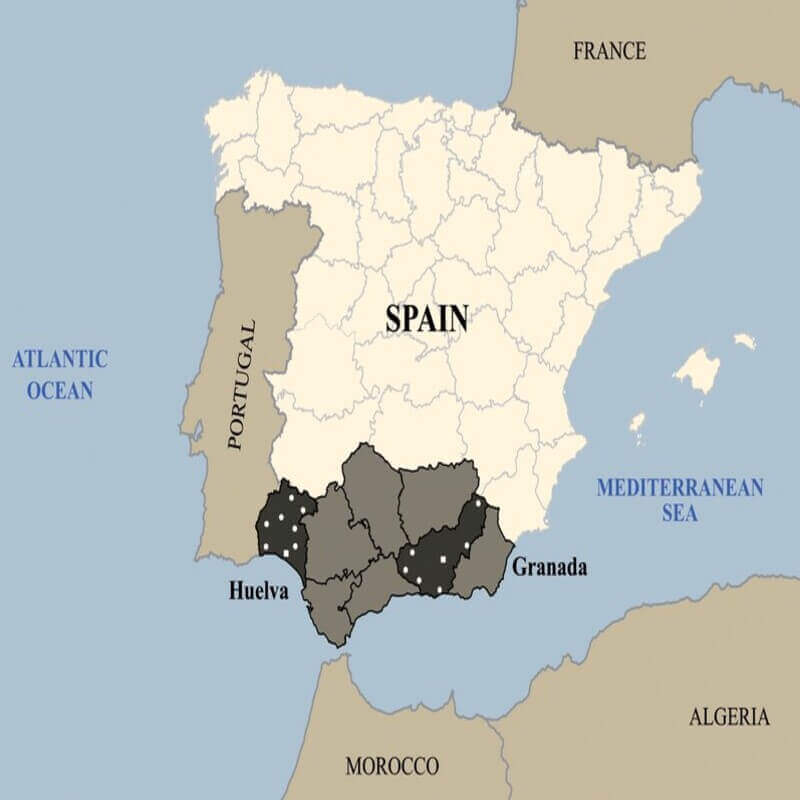
The phenomenon of Azores High influencing the climate of the Iberian peninsula has been in news. Read here to know about it in detail.
A study revealed that an extremely large ‘Azores High’ (a subtropical weather phenomenon) has resulted in abnormally dry conditions across the western Mediterranean, including the Iberian Peninsula which is a region of Spain and Portugal.
Iberian Peninsula

- The Iberian Peninsula is the westernmost of the three major southern European peninsulas- the Iberian, Italian, and Balkan.
- It is principally divided between Spain and Portugal, comprising most of their territory, as well as a small area of Southern France, Andorra, and Gibraltar.
- It is bordered on the southeast and east by the Mediterranean Sea, and on the north, west, and southwest by the Atlantic Ocean.
- The Pyrenees Mountains are situated along the northeast edge of the peninsula, where it adjoins the rest of Europe.
- Its southern tip, located in Tarifa is the southernmost point of the European continent.
- The southern tip is very close to the northwest coast of Africa, separated from it by the Strait of Gibraltar and the Mediterranean Sea.
What is Azores high?

The Azores High is also known as North Atlantic (Subtropical) High/Anticyclone or the Bermuda-Azores High.
It is a subtropical high-pressure cell that moves westward during the summer and fall when it is known as the Bermuda high. The Bermuda high is often associated with warm humid weather in the eastern United States during the summer months.
It is a large subtropical semi-permanent center of high atmospheric pressure system typically found south of the Azores in the Atlantic Ocean, at the Horse latitudes (regions located at about 30 degrees north and south of the equator).
Azores High extends over the eastern subtropical North Atlantic and Western Europe during winter.
This system influences the weather and climatic patterns in the regions of North Africa and Southern Europe, and to some extent, eastern North America.
It is associated with anti-cyclonic winds in the subtropical North Atlantic. It is formed by dry air descending the subtropics and coincides with the downward branch of the Hadley Circulation.
The large-scale subsidence and sinking motion of air in the system causes the aridity of the Sahara Desert and the summer drought of the Mediterranean Basin.
During the summers the high is centered near Bermuda and creates a southwest flow of warm tropical air toward the East Coast of the United States.
- The Azores-Bermuda High is strongest in summers with the central pressure at around 1024 mbar (hPa).
This high-pressure block exhibits anticyclonic behavior, circulating the air clockwise.
Due to this direction of movement, eastern African waves are driven along the southern border of the Azores High away from coastal West Africa towards the Caribbean, Central America, or the Bahamas, favoring tropical cyclogenesis, especially during the hurricane season.
Hadley Circulation

- Hadley Cells are the low-latitude overturning circulations that have air rising at the equator and air sinking at roughly 30° latitude.
- They are responsible for the trade winds in the Tropics and control low-latitude weather patterns.
- Hadley cells could extend to the poles.
Effects of Azores high
According to observations published in the journal Nature Geoscience:
- The Iberian Peninsula region has been recording an annual drying of 5-10 millimeters per year per decade throughout the second half of the 20th century.
- A further 10-20 percent drop in winter precipitation is expected by the end of the 21st century.
- The agriculture of the Iberian region is most impacted by these changes.
- Olive-growing regions in southern Spain will suffer a 30 percent decline in production by 2100
- Cultivation areas in grape-growing regions across the Iberian Peninsula will shrink 25-99 percent by 2050 due to severe water deficits that will render land unsuitable for viticulture.
Climate change and Azores high
Studies are indicating that global warming is intensifying the Bermuda High in the past years.
The external climate forces are driving the expansion of the Azores high especially atmospheric greenhouse gas concentrations.
It was observed that the changing atmospheric conditions since the onset of the industrial era contributed to these regional hydroclimatic changes.
- This was assessed by how the characteristics of the Azores High varied over the past 1,200 years.
- Winters with an extremely large Azores High were significantly more common in the industrial era (since 1850) than in pre-industrial times.
Azores High expansion emerged after 1850 and strengthened in the twentieth century, consistent with anthropogenically driven warming.
Way forward
The current findings are important to understand the future climate risks posed to productive agricultural sectors such as viticulture and olive plantations across the Iberian Peninsula.
From the point of view of a climatic and economic standpoint, the findings should be taken into account while making policies to tackle climate change.






Leave a Reply